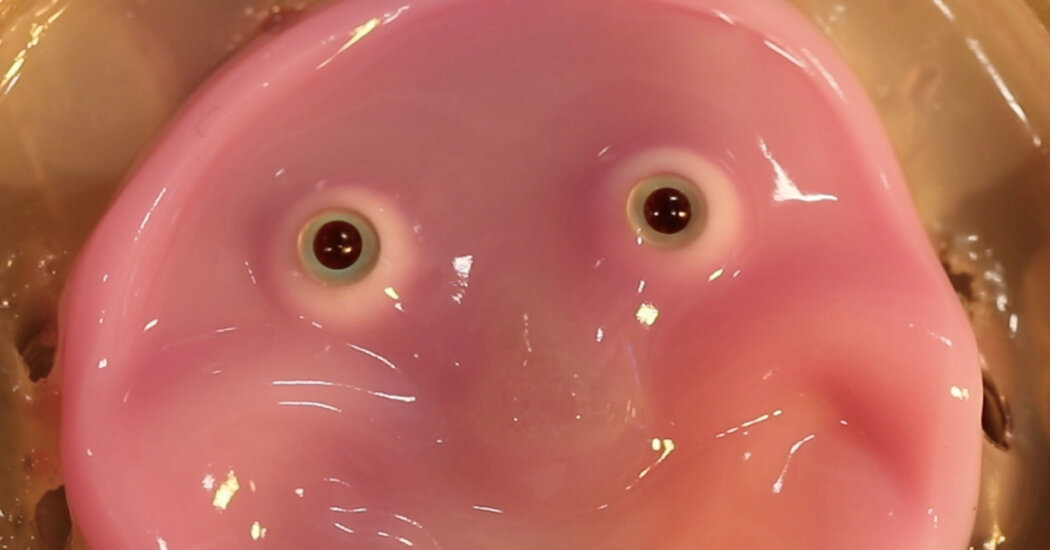Engineers in Japan are trying to make robots imitate that quintessentially human expression: the smile.
They have created a face mask made from human skin cells and attached it to robots using a new technique that hides the bond and makes the mask flexible enough to change into a grimace or a soft smile.
The effect is a combination of Hannibal Lecter's terrifying mask and the clay animation figure Gumby.
Scientists say the prototypes pave the way for more advanced robots, with an outer layer that is elastic and durable enough to protect the machine while making it look more human.
In addition to its expressiveness, the “skin equivalent,” as the researchers call it, made in a lab from living skin cells, can cause scars and burns and also heal itself, according to a study published June 25 in the journal Cell Reports Physical Science.
“Human faces and expressions enhance communication and empathy in human-robot interactions, making robots more effective in healthcare, service and companionship functions,” said Shoji Takeuchi, a professor at the University of Tokyo and lead researcher on the study, in an email.
The research is being conducted at a time when robots are increasingly found on the factory floor.
According to the International Federation of Robotics, 3.9 million industrial robots will be working on automotive and electronics assembly lines and in other work environments in 2022.
Part of the total robot pool consists of so-called humanoids. These are machines with two arms and two legs that are suitable for use in environments that are specially built for human work, such as factories, but also in the hospitality industry, healthcare and education.
Carsten Heer, spokesman for the federation, said humanoids were “an exciting area of development” but that mass adoption would be complex and could be limited by cost.
Yet in October 2023, the Chinese government announced that it planned to mass-produce humanoids by 2025, predicting that this would significantly increase industrial productivity.
For decades, roboticists have been experimenting with materials in the hopes of finding something that can protect a robot's complex machinery, yet remain soft and light enough for a wide range of applications.
If a robot's surface gets dented or scratched, it can cause the machine to malfunction, making the ability to self-repair a “critical property” for humanoid robots, the researchers said in the paper.
The new method of skin bonding advances the emerging field of “biohybrid” robotics, which combines mechanical engineering with genetic and tissue engineering, said Kevin Lynch, director of the Center for Robotics and Biosystems at Northwestern University.
“This study is an innovative contribution to the problem of anchoring artificial skin to the underlying material,” said Professor Lynch, adding that “living skin could help us achieve the holy grail of self-healing skins in biohybrid robots.”
He added that the study does not address how the robots' skin repairs itself without external support.
For such robots, the challenge with the materials lies in how realistic they are: finding ways to endow the machine with properties that make it look and behave more like a human, such as the ability to laugh.
Scientists, including Professor Takeuchi and his colleagues at the University of Tokyo, have been working with laboratory-created human skin for years.
In 2022, the research team developed a robotic finger covered in living skin, allowing the machine's finger to bend like a human finger, giving the machine the sense of touch to potentially perform more precise tasks.
Professor Takeuchi’s team had tried anchoring the skin with tiny hooks, but these caused tears when the robot moved. So the team decided to mimic ligaments, the tiny strings of loose tissue that connect bones.
Team members drilled small, V-shaped holes in the robot and applied a collagen gel to them, closing the holes and attaching the artificial skin to the robot.
“This approach integrates traditional, rigid robots with soft, biological skins, making them more ‘human,’” said Yifan Wang, an assistant professor in the faculty of mechanical and aerospace engineering at Nanyang Technological University in Singapore, who researches “soft robots” that mimic biological creatures.
The skin bonding also gives a biohybrid robot the ability to feel, bringing science one step closer to sci-fi fantasies.
“This could create opportunities for the robot to sense humans and communicate with them safely,” said Professor Wang.
The faces of the artificial-skinned robots in Professor Takeuchi's lab cannot sense touch, temperature changes or other external stimuli.
Professor Takeuchi said this is his next research goal.
“Our goal is to create skin that closely mimics the functionality of real skin by gradually constructing essential components such as blood vessels, nerves, sweat glands, sebaceous glands and hair follicles,” he said.
Instead of the neural systems that transmit sensations in a human body, a robot's electronics would have to control a sensor signal. According to Professor Wang, this development would take much more time and research.

